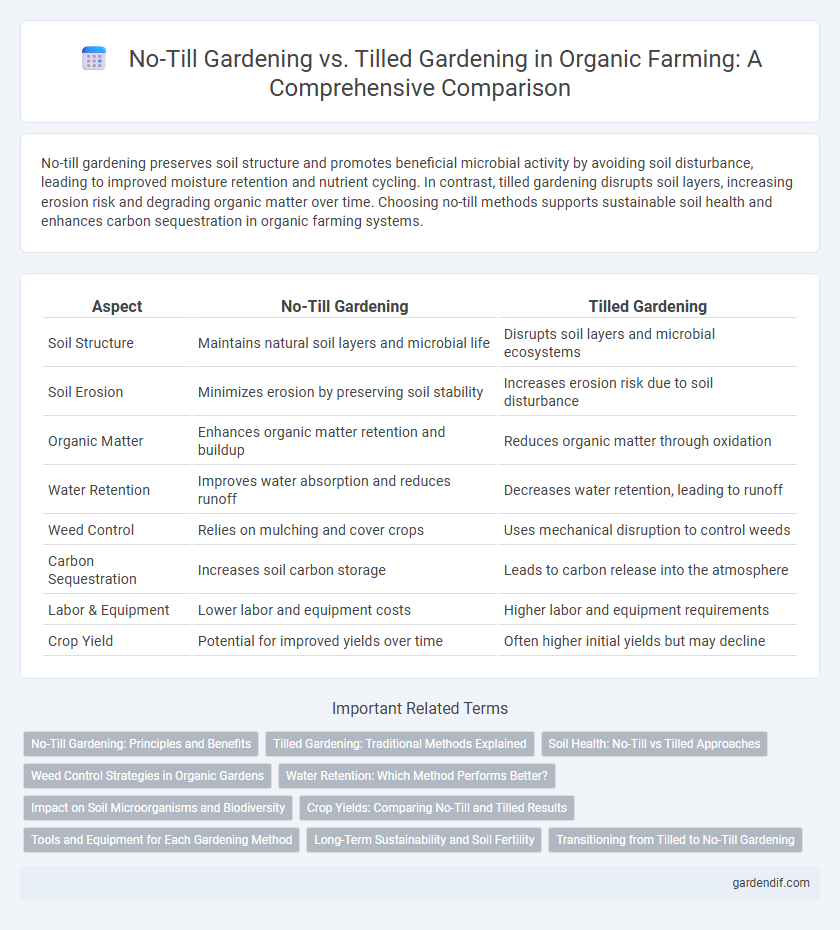
No-till gardening vs Tilled gardening Illustration
No-till gardening preserves soil structure and promotes beneficial microbial activity by avoiding soil disturbance, leading to improved moisture retention and nutrient cycling. In contrast, tilled gardening disrupts soil layers, increasing erosion risk and degrading organic matter over time. Choosing no-till methods supports sustainable soil health and enhances carbon sequestration in organic farming systems.
Table of Comparison
| Aspect | No-Till Gardening | Tilled Gardening |
|---|---|---|
| Soil Structure | Maintains natural soil layers and microbial life | Disrupts soil layers and microbial ecosystems |
| Soil Erosion | Minimizes erosion by preserving soil stability | Increases erosion risk due to soil disturbance |
| Organic Matter | Enhances organic matter retention and buildup | Reduces organic matter through oxidation |
| Water Retention | Improves water absorption and reduces runoff | Decreases water retention, leading to runoff |
| Weed Control | Relies on mulching and cover crops | Uses mechanical disruption to control weeds |
| Carbon Sequestration | Increases soil carbon storage | Leads to carbon release into the atmosphere |
| Labor & Equipment | Lower labor and equipment costs | Higher labor and equipment requirements |
| Crop Yield | Potential for improved yields over time | Often higher initial yields but may decline |
No-Till Gardening: Principles and Benefits
No-till gardening preserves soil structure by avoiding disturbance, which enhances microbial activity and organic matter retention critical for nutrient cycling. This method reduces erosion, conserves moisture, and promotes biodiversity by maintaining a stable habitat for beneficial organisms. Crop residues remain on the surface, enriching soil fertility naturally and supporting sustainable organic practices that improve long-term garden productivity.
Tilled Gardening: Traditional Methods Explained
Tilled gardening involves turning the soil using tools like plows or rotary tillers to break up compacted earth, enhance aeration, and incorporate organic matter or fertilizers. This traditional method promotes nutrient mixing and weed control but can disrupt soil structure, reduce microbial diversity, and increase erosion risks. Despite these drawbacks, many gardeners rely on tilling to prepare seedbeds and manage pests effectively in organic farming practices.
Soil Health: No-Till vs Tilled Approaches
No-till gardening preserves soil structure by minimizing disturbance, which enhances microbial activity, organic matter retention, and moisture conservation. In contrast, tilled gardening disrupts soil layers, leading to erosion, loss of beneficial microbes, and decreased soil fertility over time. Maintaining intact soil ecosystems in no-till systems results in improved nutrient cycling and long-term soil health.
Weed Control Strategies in Organic Gardens
No-till gardening enhances weed control in organic gardens by preserving soil structure and encouraging beneficial organisms that outcompete weeds. Tilled gardening disrupts weed growth temporarily but often leads to increased weed seed germination due to soil disturbance. Sustainable weed management in organic systems favors no-till methods combined with mulching and cover crops to suppress weed emergence naturally.
Water Retention: Which Method Performs Better?
No-till gardening significantly improves water retention by preserving soil structure and maintaining organic matter, which enhances moisture absorption and reduces evaporation. Tilled gardening disturbs the soil, disrupting its natural composition and leading to increased water runoff and quicker drying. Studies show no-till methods can retain up to 30% more soil moisture compared to traditional tilling, benefiting plant health during dry periods.
Impact on Soil Microorganisms and Biodiversity
No-till gardening preserves soil structure and fosters a rich diversity of microorganisms by minimizing soil disturbance, which enhances nutrient cycling and promotes healthier plant growth. In contrast, tilled gardening disrupts microbial habitats, reduces biodiversity, and can lead to soil erosion and nutrient loss. Maintaining intact soil ecosystems through no-till practices supports beneficial organisms such as mycorrhizal fungi, earthworms, and nitrogen-fixing bacteria, crucial for sustainable organic farming.
Crop Yields: Comparing No-Till and Tilled Results
No-till gardening enhances soil structure and moisture retention, often leading to higher crop yields compared to tilled gardens, which can disrupt soil ecosystems and nutrient availability. Studies show no-till methods increase microbial activity and organic matter, promoting healthier plant growth and improved resilience against drought. Conversely, tilled gardens may initially boost yield through aeration but risk long-term soil degradation and reduced productivity.
Tools and Equipment for Each Gardening Method
No-till gardening relies on minimal disturbance tools such as broadforks, hori hoes, and hand rakes to aerate soil without turning it, preserving soil structure and microbial life. Tilled gardening requires heavier equipment including rototillers, plows, and garden forks, which break up soil and mix in organic matter but can disrupt soil ecology. Choosing between these methods impacts tool investment, with no-till favoring sustainable, low-impact tools and tilled gardens demanding more mechanized equipment.
Long-Term Sustainability and Soil Fertility
No-till gardening enhances long-term sustainability by preserving soil structure, promoting microbial diversity, and reducing erosion compared to tilled gardening. Tilled gardening disrupts soil aggregates and depletes organic matter, leading to diminished soil fertility over time. Maintaining undisturbed soil layers in no-till practices fosters nutrient retention and improves moisture conservation for sustained crop productivity.
Transitioning from Tilled to No-Till Gardening
Transitioning from tilled to no-till gardening enhances soil health by preserving organic matter and promoting beneficial microbial activity. No-till practices reduce erosion and improve moisture retention, leading to sustainable crop yields and lower labor inputs. Incorporating cover crops and organic mulches during this transition supports weed suppression and nutrient cycling in organic gardens.
No-till gardening vs Tilled gardening Infographic

 gardendif.com
gardendif.com